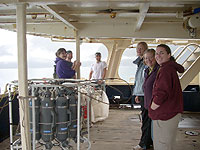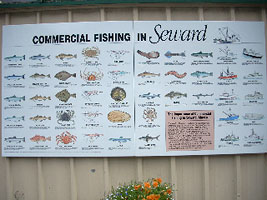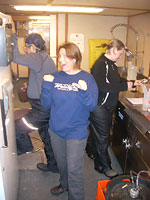

 | |||||||||||||||||||
|
|
Journals 2009/2010Jennifer Duncan
September 17, 2009 We were working very hard today making up for lost time. Dr. Mathis and I were standing on the deck watching the CTD cable line drop down into the deep. We knew we had a lot of samples to collect ahead of us. The sun was just beginning to rise above the horizon. I began to ask a few questions about his research experience here in the Gulf of Alaska. One of the main focuses has been ocean scidification. This means that if pH level of the ocean decreases the ocean acidity is increasing. The ocean absorbs carbon dioxide (CO2) from the air which in effect increases the acidity. Obviously, there has been an increase with atmospheric CO2 levels therefore directly effects the pH levels of the seawater. He said the pH levels have actually dropped from pre-industrial 8.2-8.25 to post-industrial 8.1-8.15. This does not seem like a lot to a normal person; however to a scientist this drop of a pH level is a lot. Why is this significant? Marine organisms such as plankton or invertebrates need minerals to build their shell or exoskeleton. The pteropods, coccolithophores or larger organisms like the oysters or Alaskan King Crab could have difficulty building their outer layer of protections when the water is more acidic. If the water is acidic enough, in some situation their shell can actually break down. This can dramatically change the food chain including our very own diet. One of the main focuses on this trip was to collect water from the Seward Line at every station, at all depths, all the way out to 130 miles offshore to test for this sort of thing. Kristen Shake, a University of Alaska graduate student, Master's project is to collect containers of all these water samples and bring them back to the lab to be tested. Specific chemical analysis like dissolved inorganic carbon (DIC) and dissolved organic carbon (DOC) will be evaluated. This will help properly evaluate ocean acidity. As Dr. Mathis stated in one of his many publications Ocean acidity is often referred to as the "sister problem to climate change."
Questions: |
||||||||||||||||||



